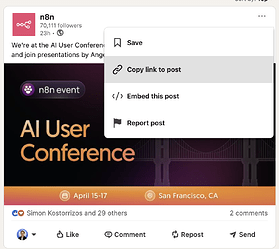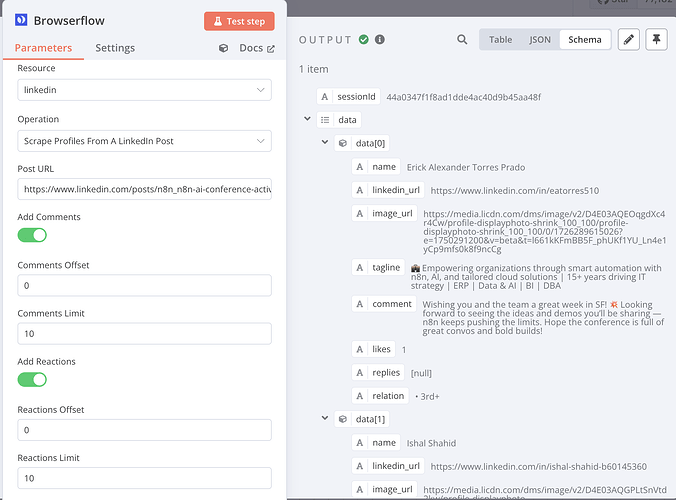We’ve been using this internally at Browserflow lately and it’s quickly become one of our favorite ways to find highly relevant prospects on LinkedIn.
Instead of cold outreach, we look for posts in our niche (like the ones from n8n) and then scrape everyone who commented or reacted using a Browserflow automation inside n8n itself.
It’s fast, targeted, and surprisingly personal — because these are people already engaging with content in the space. You can then use other Browserflow actions to send connection invites or messages to further interact with these prospects.
Here’s a step-by-step if you want to try it too ![]()
Step 1: Install the Browserflow Community Node
To get started, you need to install the community node that connects n8n with Browserflow.
- In n8n, go to Settings > Community Nodes
- Search for:
n8n-nodes-browserflow - Install it and restart your n8n instance if needed.
Step 2: Get Your Browserflow API Key
- Go to Browserflow and sign up for the free 7-day trial.
- Once inside, you’ll find your API Key under your account settings or dashboard.
- Copy this key — you’ll need it in n8n to authenticate your flows.
Step 3: Grab the LinkedIn Post URL
- Go to the LinkedIn post you want to scrape.
- Click the three dots at the top right of the post.
- Click “Copy link to post.”
- This will give you the direct URL needed for scraping.
Step 4: Use the “Scrape Profiles from a LinkedIn Post” Flow
- In n8n, use the Browserflow Node and select the “Scrape Profiles from a LinkedIn Post” action
- Input your LinkedIn post URL into the action.
- Select if you want to scrape comments, reactions or both and set offset to limit the costs.
- Run the flow — and voilà! You now have a list of people who engaged with that LinkedIn post.
 Pro Tips: How to Use the Scraped Data
Pro Tips: How to Use the Scraped Data
![]() Expand your network with laser focus:
Expand your network with laser focus:
- Connect with people commenting or reacting to posts in your niche.
- These users are already active and interested — perfect candidates for outreach.
![]() Analyze engagement on your own posts:
Analyze engagement on your own posts:
- Scrape the people who engage with your own content to identify:
- Followers who are most active
- Potential leads or advocates
- Trends in who resonates with your messaging
![]() Target third-party audiences:
Target third-party audiences:
- Scrape engagement from posts made by competitors or partner brands, e.g.:
- People interacting with posts by n8n, or industry influencers.
- Use this to build prospect lists or identify partnership opportunities.
Let me know if this is clear to you or when you need some help!


